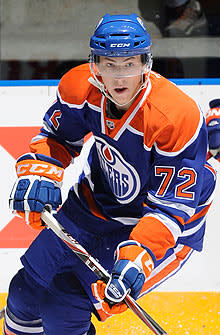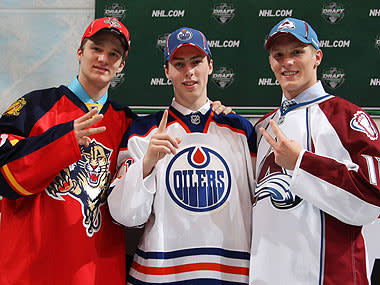No. 1 goal: Nugent-Hopkins aims for Oilers
Back in May, before he became the No. 1 pick in the NHL draft, Ryan Nugent-Hopkins(notes) was having dinner with Edmonton Oilers head scout Stu MacGregor. The kid had a lot on his plate – literally and figuratively.
"You know," Nugent-Hopkins told MacGregor at one point, "I eat a lot."
"Probably you do," MacGregor responded with a laugh. "I was like you at one time, but look what happened."
Oh, to be 18 again. To be able to put away plate after plate without packing on pound after pound.
"It seems like no matter what I eat or how much I eat of it, I can't put on too much weight," Nugent-Hopkins said in a recent interview. "It's like once I get to a certain point, I'm not crossing there until next year or something."
Must be nice.
Except for Nugent-Hopkins, this is an issue. When he reports to the Oilers' main training camp on Friday, he will be going to Weight Watchers in reverse. Fans, media and team officials will be watching to see whether he is big enough to play with the big boys or should return to junior to fill out his frame.
"It's like any young player," MacGregor said. "There's always that question mark: Are they physically ready?"
Understand, though, that the answer to that question won't be found on the scale. Nugent-Hopkins was listed at 6-foot-1 and 164 pounds at the draft in June, though he said he was 172 at the time. The Oilers currently list him at 6-feet and 171 pounds, though he has said he is between 175 and 177.
People used to ask Nugent-Hopkins if he needed to put on weight; now they ask him if he has put on too much and will be sluggish. Either way, they're missing the point, according to his longtime personal trainer, Carlo Sferra. "This thing has gone back and forth, and honestly, the weight thing is so overrated," Sferra said.
Like age, weight is just a number. The bottom line will be performance, not pounds. Nugent-Hopkins is a playmaking centerman, not a power forward, and has been training in specific ways – hoping to add not only muscle mass, but more strength, speed and explosiveness to go with the qualities that made him the top pick in the first place. He and his trainer are confident that work will pay off.
"I've just got to show them I'm ready," Nugent-Hopkins said. "I think the physical part is what they're going to be watching a little bit more. So I'm just going to try to be strong on my feet and protect the puck as well as I can, just not get rid of the puck too fast and just have confidence with the puck."
Said MacGregor: "All we need to see is that Ryan can compete in the heavy areas and is able to keep his game at the same skill level that he has now playing with bigger men. … He may be at that level where he's able to compete because of his intelligence, his smarts, on-ice vision, and not miss a beat. But the men are bigger, they are quicker, they are more experienced, and it is the best league in the world."
* * * * *
Nugent-Hopkins did not gnaw on red meat, swallow raw eggs or simply pump iron. He is not a bodybuilder; he is a hockey player. He went through a sophisticated off-season program of nutrition, off-ice training and on-ice drills tailored by Sferra, with whom he has worked since he was an 11-year-old in Burnaby, B.C.
"He knew he had to gain some weight, because, yes, he had a slight frame, and, you know, there was some pressure from some people that were involved with him that thought that it would be in his best interest," Sferra said. "But you have to look at what Ryan has done to get to this point. Ryan has never been a big guy. He's been a very slight boy his whole life, and genetically, that's just the way the process of human physical development evolves. You can't force the hands of nature."
The nutrition might have been the easy part. Want to gain weight? The easy route is the drive-thru. But Nugent-Hopkins said he doesn't really like fast food and doesn't have a weakness for any particular treat. He fed that active metabolism lots of protein, lots of carbs, lots of fruit.
His workout regimen went through stages. First, a transition period of rehab and rest. Second, an adaptation period that prepared his body for the work to come – strengthening the muscles surrounding his joints, strengthening his core to support his spine. Third, a mass-building phase. This is where he put on most of his weight, and the timing coincided with the lead-up to the NHL draft combine. Sferra shifted some strategy so Nugent-Hopkins would fare well on specific tests. Next, a strength-oriented phase. Finally, a velocity phase.
"It's one thing to gain size and strength, but then you have to be able to use that in a very explosive manner," Sferra said.
Throughout his regimen, Nugent-Hopkins did things in the gym as a hockey player would do them on the ice. He didn't perform, say, conventional dead lifts. He mimicked ranges of motion through which he would go in a game, working on movement strength instead of isolated muscle strength. He also worked on things like balance and flexibility.
"All these things in the end acclimate to better performance or better transition of performance from the gym environment to the on-ice competitiveness," Sferra said. "You still have to bridge the gap. You still have to take everything that you did in the gym on the ice, and with the on-ice high-performance work that I do, it bridges the gap."
Nugent-Hopkins had so many demands on him in the off-season – the combine, the draft, an Oilers camp, a Hockey Canada world junior camp – that his regimen was interrupted repeatedly. Had he been able to focus only on his training, he might have been able to add even more weight, more strength, more explosiveness.
But more weight is going to come as he matures – at 18, he's just entering adulthood – and he gets the most out of the weight he has.
"We're talking about a kid that may appear slight on the surface, but if we look at strength-to-mass ratio, pound for pound, this boy is very strong," Sferra said. "He wouldn't be able to play at a high level if he wasn't. We've done lots of work … so that he's able to take the punishment, deliver a check, receive a check, be strong on the puck, be strong in the more combative areas on the ice, and he's fared very well with that, and he's fared very well against big boys. He's obviously succeeded to the level he has. He's picked No. 1 overall for a reason in spite of his slight frame."
* * * * *
The Oilers had the No. 1 pick in the draft last year, too. Taylor Hall(notes) made the team out of training camp. "He needs to play against men," Oilers general manager Steve Tambellini said then.
Hall was physically ready, a broad-shouldered 6-foot-1, 185-pounder. He had nothing left to learn in junior. Though they knew there would be ups and downs, the Oilers wanted Hall to grow together with fellow first-round picks Magnus Paajarvi(notes) and Jordan Eberle(notes). At one point, coach Tom Renney, known as a teacher, called it the "University of the National Hockey League."
Ideally, RNH will matriculate to the UNHL this fall. Nugent-Hopkins doesn't need the body that Hall had as a rookie. He won't be racing the puck up the left-wing wall, as Hall likes to. Many envision him as the one who will give the puck to Hall on the move. Many see him setting up Hall and company in the offensive zone.
"His bread and butter isn't going in the corners and winning battles and that kind of stuff," Hall said. "It's playmaking. It's on the power play, making that cross-ice pass. I think that's what they drafted him for."
The Oilers also drafted him partly because of his mental makeup. Could he handle taking his lumps, the way Hall did early last season before hitting his stride? MacGregor remembered how Nugent-Hopkins struggled to score last November but didn't show his frustration, kept working, kept playing hard.
"There's obviously been pressure," MacGregor said. "When you've been rated as one of the top players for probably since you put on skates, sometimes it can be a little bit overwhelming, and kids do react strangely. But he never did. He's just a solid person."
But Nugent-Hopkins is almost a half-year younger than Hall was as a rookie – Hall turned 19 on Nov. 14; Nugent-Hopkins won't be 19 until April 12 – and the Oilers are coming off two straight seasons in the NHL's basement. They have added veterans Ryan Smyth(notes), Ben Eager(notes), Darcy Hordichuk(notes) and Eric Belanger(notes) up front. Hall went as far as to say: "This year is hopefully the year where our rebuild's over and we start taking the next step. … I think the playoffs is a pretty attainable goal for us."
The Oilers are balancing urgency and patience. If Nugent-Hopkins isn't ready to be a first- or second-line center for a team trying to take the next step, would he be better off returning to the Red Deer Rebels in the Western Hockey League and playing for Canada in the World Junior Championship? The Rebels play just down the road; the WJC is in Alberta this year.
"We're not the greatest team in the world," MacGregor said. "At this point in our development, we don't have [the personnel] where we can just hide a player and he could play some specific situations. We need a player who can play every fourth shift. …
"We believe in Ryan. We have a huge belief in Ryan's ability and what he's going to be, and we believe in the plan we put into place with our team and with Ryan and with all the young guys. We're not going to rush anything. If he's ready to play, then the coach will say he's ready to play. If he's not ready to play, then he'll be back in junior for a year and able to experience the whole world junior experience and everything else."
Nugent-Hopkins said he would be fine either way but emphasized he will do everything he can to make the Oilers. He said he had worked for it. He said he should be ready. He said he feels ready.
The Oilers have told him one thing will weigh heaviest in the end.
"All they really said was it's really up to me," Nugent-Hopkins said, "depending on how good I play."


